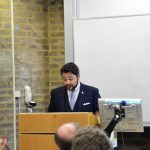
Jon-Mark Grussenmeyer reading from ‘The General Prologue’ to The Canterbury Tales.
A guest post by J.M. Grussenmeyer
When thinking about medieval and early modern performance texts, plays such as Everyman and the works of Marlowe or Shakespeare no doubt first spring to mind. However, Cultures of Performance in Medieval and Early Modern Europe, an exciting new research cluster based in the Centre for Medieval & Early Modern Studies at the University of Kent, offers a far more expansive view of what encompasses performative texts.
Cultures of Performance was officially launched on 12 October before a packed lecture theatre. To introduce the research cluster and its goals, founding academics Sarah Dustagheer, Rory Loughnane, and Clare Wright chose three medieval and early modern texts that are not explicitly works of performance. Several postgraduate students, myself included, performed these texts and invited the audience to engage with the process by discussing our performance choices and debating the impact and significance of performing such texts in medieval and early modern Europe.
I performed excerpts from the ‘GeneralPrologue’ and the ‘Miller’s Tale’ from Chaucer’s Canterbury Tales, exploring the relationship between narrating and voicing characters within the Tales. Though I have studied and lectured on Chaucerian literature, this was new territory for me, and it opened my eyes to subtle nuances of Chaucer’s authorship and the complex relationship between written text and performance, as well as the nature of medieval reading practices. My most obvious — and difficult — choice was how precisely to perform tales within tales. Though I read the narrative sections as though I were Chaucer the narrator, I chose to give different voices and accents to the various characters throughout the excerpts. The ‘Miller’s Tale’ proved particularly challenging in terms of voicing — in the end, I decided to read the whole tale as if Chaucer the narrator were adopting an altered voice and accent appropriate to the Miller. In the same way, I also gave the characters within the tale voices that the Miller himself might have provided. After I finished, I read the tale again, but this time different actors delivered the passages spoken by characters within the tale (i.e. John, the carpenter, and Nicholas, the scholar), leaving me to read only the Miller’s narrative parts in his own voice. Each method of reading aloud had its own peculiar effect upon the audience; the closest comparison I can make is the difference between listening to an audio book and watching a film.
Interestingly, it became clear that, while much of Chaucer’s text works well when read aloud, several passages suggest private reading. For example, Chaucer the narrator prefaces the ‘Miller’s Tale’ with an apology and a disclaimer, advising readers that ‘…whoso list it nat yheere, turne over the leef and chese another tale’. Copies of his work were widely disseminated to individual readers, yet there is also pictorial evidence that his work was read aloud. Although we can never know for certain exactly how medieval readers or listeners engaged with works like the Canterbury Tales, testing different modes of performance before an audience of fellow scholars raised thoughtful questions and fascinating possibilities about the purpose and impact of the written and spoken word upon late medieval society. I research the writing and rhetoric that the Lancastrian dynasty employed for political purposes, and taking part in this research cluster has broadened the way that I think about those sources, whether a tract by Lydgate or a chancellor’s opening sermon summarised in the parliament rolls. Crossing disciplinary divides, rethinking old assumptions, pushing the bounds of what we can discover about medieval and early modern culture — these are the significant results of a research cluster like Cultures of Performance, and I feel privileged to take part in it.